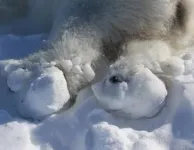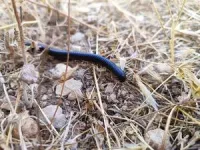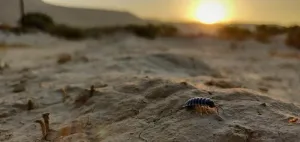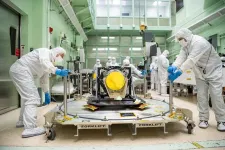(Press-News.org) Polar bears in some parts of the high Arctic are developing ice buildup and related injuries to their feet, apparently due to changing sea ice conditions in a warming Arctic. While surveying the health of two polar bear populations, researchers found lacerations, hair loss, ice buildup and skin ulcerations primarily affecting the feet of adult bears as well as other parts of the body. Two bears had ice blocks up to 1 foot (30 centimeters) in diameter stuck to their foot pads, which caused deep, bleeding cuts and made it difficult for them to walk.
The study led by the University of Washington was published Oct. 22 in the journal Ecology. It’s the first time that such injuries have been documented in polar bears.
The researchers suggest several mechanisms for how the shift from a climate that used to remain well below freezing to one with freeze–thaw cycles could be causing ice buildup and injuries.
“In addition to the anticipated responses to climate change for polar bears, there are going to be other, unexpected responses,” said lead author Kristin Laidre, a senior principal scientist at the UW Applied Physics Laboratory and a professor in the UW School of Aquatic and Fishery sciences. “As strange as it sounds, with climate warming there are more frequent freeze-thaw cycles with more wet snow, and this leads to ice buildup on polar bears’ paws.”
Between 2012 and 2022, Laidre and co-author Stephen Atkinson, a wildlife veterinarian, studied two populations of polar bears living above 70 degrees north latitude and saw the injuries.
In the Kane Basin population, located between Canada and Greenland, 31 of 61 polar bears showed evidence of icing-related injuries, such as hairless patches, cuts or scarring.
In the second population in East Greenland, 15 of 124 polar bears had similar injuries. Two Greenland bears at separate locations in 2022 had massive ice balls stuck to their feet.
“I'd never seen that before,” Laidre said. “The two most affected bears couldn't run — they couldn't even walk very easily. When immobilizing them for research, we very carefully removed the ice balls. The chunks of ice weren't just caught up in the hair. They were sealed to the skin, and when you palpated the feet it was apparent that the bears were in pain.”
Researchers have studied these two polar bear populations since the 1990s but haven’t reported these types of injuries before. Consultations with lifetime Indigenous subsistence hunters and a survey of the scientific literature suggests this is a recent phenomenon.
Polar bears have small bumps on their foot pads that help provide traction on slippery surfaces. These bumps, which are larger than those on the pads of other bear species like brown and black bears, make it easier for wet snow to freeze to the paws and accumulate. This problem also affects sled dogs in the North.
The authors hypothesize three possible reasons for increasing ice buildup on polar bears’ paws — all related to climate warming. One is more rain-on-snow events, which creates moist, slushy snow that clumps onto paws and then freezes to form a solid once temperatures drop.
A second possibility is that more warm spells are causing the surface snow to melt and then refreeze into a hard crust. The heavy polar bears break through this ice crust, cutting their paws on its sharp edges.
The final possible reason is that both these populations live on “fast ice” connected to the land, near where freshwater glaciers meet the ocean. Warming in these environments leads to thinner sea ice, allowing seawater to seep up into the snow. This wet snow can clump onto bears’ feet and then refreeze to form ice. Also, unlike other areas, polar bears living at glaciers’ edges rarely swim long distances in spring, which would help thaw and dislodge accumulated ice chunks because the water is warmer than the air.
While the bears are clearly affected by the ice buildup, the researchers are cautious regarding broader conclusions about the health of the two populations.
“We’ve seen these icing-related injuries on individual polar bears,” Laidre said. “But I would hesitate to jump to conclusions about how this might affect them at a population level. We really don’t know.”
Melinda Webster, a research scientist at UW’s Applied Physics Laboratory, recently published a separate study analyzing snow cover on Arctic sea ice over recent decades.
“The surface of Arctic sea ice is transforming with climate change,” Webster said. “The sea ice has less snow in late spring and summer, and the snow that does exist is experiencing earlier, episodic melt and more frequent rain. All these things can create challenging surface conditions for polar bears to travel on.”
Asked what can be done to help the polar bears, Laidre had a simple response: “We can reduce greenhouse gas emissions and try to limit climate warming.”
The field observations of polar bears were funded by the governments of Canada, Denmark, Nunavut and Greenland. Laidre is also affiliated with the Greenland Institute of Natural Resources.
END
Paws of polar bears sustaining ice-related injuries in a warming Arctic
2024-10-22
ELSE PRESS RELEASES FROM THIS DATE:
Politics may influence gift-giving choices more than personal purchases
2024-10-22
DURHAM, N.H.—(October 22, 2024)—Political affiliation may not make a difference on everyday purchases for individuals, but it can play a role when buying for friends, family and co-workers, new research from the University of New Hampshire has found. This may have implications for gift buying this holiday season and beyond.
“We performed five different studies, each looking at buying different products, and asked people to make a choice for themselves and then a gift for someone they knew really well and found that politics played a bigger role when people were purchasing gifts, because that's a case where people are making a decision based ...
Listening skills bring human-like touch to robots
2024-10-22
Note to Editors: Video clips available at: https://duke.box.com/s/wtq3ofu3kf84ayw3qr6jajxdizt0rwxc
DURHAM, N.C. – Imagine sitting in a dark movie theater wondering just how much soda is left in your oversized cup. Rather than prying off the cap and looking, you pick up and shake the cup a bit to hear how much ice is inside rattling around, giving you a decent indication of if you’ll need to get a free refill.
Setting the drink back down, you wonder absent-mindedly if the armrest is made of real wood. After ...
Acclaimed WVU doctor and researcher elected to National Academy of Medicine
2024-10-22
A world-renowned West Virginia University physician and researcher has received one of the highest honors in the fields of health and medicine.
Dr. Sally Hodder, director of the West Virginia Clinical and Translational Science Institute, associate vice president for clinical and translational science at WVU and Chancellor’s Preeminent Scholar Chair, was elected to the National Academy of Medicine for her accomplishments as an infectious diseases physician and researcher.
Hodder, the first person from WVU to be chosen for the National Academy of Medicine, is one of only 100 new members from around the world announced at the Oct. 21 NAM ...
New study reveals larger insects' critical role in decomposition in arid ecosystems
2024-10-22
New study reveals that in arid ecosystems, larger arthropods such as termites and beetles play a crucial role in decomposition, challenging the traditional view that microbial activity dominates this process in dry environments. By demonstrating that macro-decomposition can peak during the summer in arid sites and that overall decomposition rates in these regions can be similar to or even exceed those in wetter climates, the research provides new insights into how decomposition functions in drylands and its implications for global carbon ...
NASA reveals prototype telescope for gravitational wave observatory
2024-10-22
NASA has revealed the first look at a full-scale prototype for six telescopes that will enable, in the next decade, the space-based detection of gravitational waves — ripples in space-time caused by merging black holes and other cosmic sources.
The LISA (Laser Interferometer Space Antenna) mission is led by ESA (European Space Agency) in partnership with NASA to detect gravitational waves by using lasers to measure precise distances — down to picometers, or trillionths of a meter — between a trio of spacecraft distributed in a vast configuration larger than the Sun. Each side of the triangular array ...
A new kind of authoritarianism: Democracy in decline at home and abroad
2024-10-22
A majority of Americans worry this year’s general election will be tainted by fraud, according to a recent NPR/PBS News/Marist poll released earlier this month—an ominous indication of the state of democracy in the U.S.
“When citizens lose trust in the electoral process, they may question the legitimacy of elected officials and the institutions they represent, which undermines the foundational principle that government authority is derived from the will of the people,” ...
Performance in physical tests can help manage treatment for metastatic lung cancer
2024-10-22
A study of patients with metastatic lung cancer by researchers based in Brazil and the United States has found that their performance in simple physical tests such as sitting down, standing and walking can help physicians arrive at a prognosis and approach to treatment.
An article on the study is published in the European Journal of Clinical Investigation.
The findings also included identification in the volunteers’ blood plasma of two substances – serine and M22G – with the potential to become biomarkers capable of indicating which patients are most likely to respond to chemotherapy.
The study was supported by FAPESP (projects 16/20187-6 and 19/17009-7), ...
Expanding access to weight-loss drugs could save thousands of lives a year
2024-10-22
New Haven, Conn. — Expanding access to new, highly effective weight-loss medications could prevent more than 40,000 deaths a year in the United States, according to a new study led by researchers at Yale School of Public Health and the University of Florida.
The findings highlight the critical need to remove existing barriers that are hindering people’s access to effective weight loss treatments and impeding public health efforts to address the national obesity crisis, the researchers said. According to the U.S. Centers for Disease Control and Prevention, about 74% of Americans are considered overweight, with about 43% of those individuals ...
Harnessing science to tackle global crises
2024-10-22
In a paper published in PLOS Sustainability and Transformation, an international team of researchers looked at how science could play a more active role in managing crises. The paper builds on the outcomes of the international conference “What Role for Science in Crisis Times? Outlook in the Health, Environment, and Agriculture Interconnected Areas”, held in Montpellier in 2022.
To enhance science’s contribution to crisis management, the paper emphasises the need for interdisciplinarity, where science is integrated across disciplines, and transdisciplinarity, which incorporates various societal actors and stakeholders. By co-designing and co-producing ...
Caltech's new fingerprint mass spectrometry method paves the way to solving the proteome
2024-10-22
Caltech scientists have developed a method driven by machine learning that allows them to accurately measure the mass of individual particles and molecules using complex nanoscale devices. The new technique opens the possibility of using a variety of devices for the measurement of mass and, therefore, the identification of proteins, and could pave the way to determining the sequence of the complete proteome, the collection of all the proteins in an organism.
Proteins are the engines of living systems. Which proteins are made, ...






